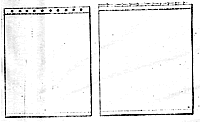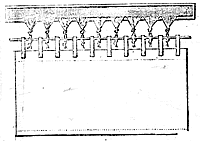- Home
- Resurrection ▾
-
Learn ▾
- Free library
- Glossary
- Documents
- Initiation
-
Shaped fabrics
- Introduction
- Popularization
- Definitions
- Le métier de façonné
- Principes du façonné
- Mécaniques de façonné
- Le jeu des crochets
- Les cartons
- Chaîne des cartons
- Mécanique 104 en détail
- Pour en finir
- Montage façonné
- Empoutage 1/3
- Empoutage 2/3
- Empoutage 3/3
- Punching, hanging and dip
- Autres façonnés
- Façonnés et Islam
-
Cours de tissage 1912
- Bâti d'un métier
- Le rouleau arrière
- Les bascules
- Formation du pas
- Position de organes
- Mécanique 104 Jacquard
- Fonctionnement 104
- Lisage des cartons
- Le battant du métier
- Le régulateur
- Réduction et régulateur
- Mise au métier d'une chaîne
- Mise en route du métier
- Navettes à soie
- Battage
- Ourdissage mécanique
- Préparation chaînes et trames
- Equipment ▾
- Chronicles ▾
- Fabrics ▾
- Techniques ▾
- Culture ▾
- Language ▾
The nodes made at the end of the warm having been completed, the front roller is placed on its supports and suspended either by ropes or by pullers. Then it is necessary to tie the chain to the equanciers to be able to make it tender. To make pulling it is sufficient when the seals are fixed to the roll of cloth to turn the crank of the regulator after having checked that the rockers of the chain roller and the cords play well in order to avoid accidents and to give a suitable tension also Warp threads.
After having tightened the chain, it is necessary to permanently suspend the healds from the shed to their respectof slings and then level them at the height where they are to be found during weaving, height in relation to that of the chain roller and that of the roller, Fabric and dependent on the movement of the yarns.
When the shed is thus suspended, the counterweights are attached to the lower straps of each rail to make the stitches tighten and also to make each stick return to the bottom of the shed, frankly to its lower position. These cast iron counterweights are referred to in the Lyons region as platinums.
The counterweights can be replaced by coil springs attached to the floor and attached to pitons in the thickness of the lower legs of each rail. The strength of the coil springs and the size of the counterweights vary with the number of meshes of each rail, the size and nature of the warp yarns and the type of armor to be made. Usually the plates used for the silk fabrics executed with a wire net weigher weigh 500 to 1200 gr for a width of 50 to 80 cm of fabric.
When the shed is adjusted leveled, the scales checked, the chain remondée and all the organs developed, the worker weaves the drag, ie weaves a few cms of fabric to equalize the tension of all the wires.
To make the first drawer, you must start by very slowly weaving the first blows by releasing the wires with the hand behind the comb.
After making sure that the walk is perfectly clear, we must weave for 3 to 4 cms, then pass in the opening of the pitch a wooden or iron rod called compasteur which must be used for the blistering.
When all the faults have been corrected, the worker begins to weave by making the hems work according to the armor requested of him and by placing the weft which is to form the fabric.
All the daggers, whether at the beginning of the chain or at the end of a cut or a piece, should preferably be made with the taffeta weave and, if possible, using a colored weft very different from that of the warp threads. That the faults are very visible.
Starting a loom after twisting:
As a result of twisting, the start-up of a loom is done faster than after remounting and comb stitching. It is enough to pull the twists forward of the comb, then to weave the drawer, the healds having kept their height and their equipment. In order to weave it is necessary to replace the rods by twisting round rods or flat rods and then carry the rods towards the chain roller and to reassemble very carefully all the threads to pass the twists to the shed and the comb.
The passage of the twists to the shed and to the comb, which is obtained by turning the roll of cloth by the regulator, requires great care. In fact, when the twists arrive towards the first heald of the remounting, it is necessary to disengage the meshes and the wires with care so that the outfits that form between the wires do not cause the rupture.
When the twists have been drawn in front of the comb, the worker must draw the taffeta with taffeta weave if possible and then check for mistakes that have not occurred in the twisting.
Stripping and winding of the fabric:
Lead weaving - When the drawer is finished and the corrected faults begin weaving the warp with the correct weave and weft, at the beginning and at the end of the piece it must make the leader, a kind of countermark woven in the Chain, which is presented in very different forms. Sometimes it is a ribbon bearing the names and inscriptions of the House, at other times it is simply one or more small ribbons of a few blows woven with a weave or a different armor from that of the piece.
The finished leader, we have to weave the cut (about 30 cm) to bring the first drawer on the roll of cloth. The finished worker loosens the chain, removes the coin seals and fixes the compassor of the drawer in the groove of the cloth roll, and then places a paper between the cloth and the roll. Once done, the worker again tends the chain by adjusting the fabric with respect to the comb and continuing to weave. These latter preparations are commonly referred to as weaving the facings, winding
In the Lyonnaise region, an assemblage of ropes, laces, or a cloth of a length of about 50 cm, one end of which is fixed to the roll of cloth, the other Being connected by any means to the beginning of the chain. The aim of the equantites is thus to avoid the loss of chain which would occur if the chain were fixed directly to the roll of cloth.
Getting Started
The various operations which are grouped under the general name of starting a craft aim at completing the organization of the healds, of the comb, in a word, of everything that commands weaving or directs the threads of the warp, to put in place the various organs of the loom to enable them to function in good conditions and finally to weave a few centimeters of cloth (the drawer) in order to be able to search and correct any errors that might have occurred during the passage Of the threads in the shed and the comb.
Whenever a new warp is placed in the loom by a resetting or twisting, it is necessary to proceed, of course, as a result of simple twisting as well as following a resetting and stitching in a comb .
First start-up of a business:
When combing and stitching are finished, all the threads of the warp must be brushed in front of the comb to tie them together in small packages, grouping together the threads contained within 3 to 4 cm of the comb, The ends of the wires are made 2 nodes spaced about 3 cm apart which will be used to fix the packages of wires to a compiler or to the chords necessary to make the warp tighten.


Practical hand weaving course
Lyon Municipal Weaving SchoolProfessor A.CREPT - Year 1912-1913
The handwritten course has been copied by us.This hand weaving course on looms was used until the 1980s.
